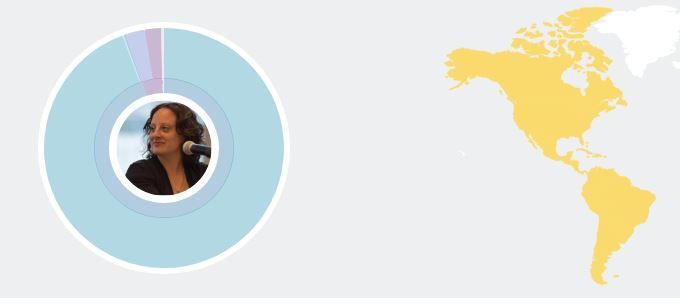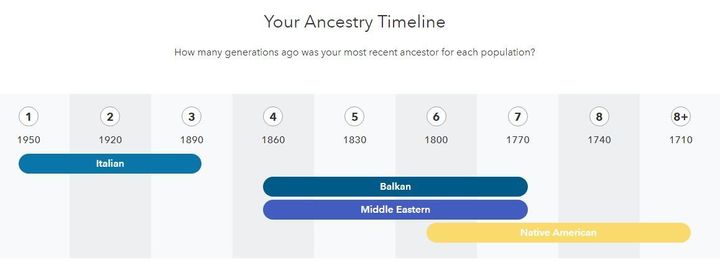
Where do you come from?
More than 2 million people have taken part in genetic testing by 23andMe, a company founded in 2006 by CEO Anne Wojcicki. The company’s impetus was to empower the consumer with information regarding their personal DNA and accelerate genetic research on a wide range of health conditions from Parkinson’s disease to lupus and asthma. Customers are not obligated to take part in the research, but many opt-in at their own discretion in an effort to further genetic profiling.
By signing up for the Ancestry Service, 23andMe participants receive access to view a percentage breakdown of their ancestry by regions that include eastern Asia, Sub-Saharan Africa, Europe, Oceanian, and others. Results show when different ancestries were introduced into your specific DNA so that you can learn how many generations ago you had an ancestor that was descended from a single population or ethnicity.
In addition, 23andMe delivers an anonymous report so that you can see how many DNA Relatives you have around the world. There is an opt-in opportunity as well to connect with DNA Relatives via messaging through the interface. If you opt in to DNA Relatives, you will be able to send and receive invitations to connect with other customers who share DNA with you. You can choose whether to respond to these invitations or not, and your DNA relatives have the same choice.
The Power Of Genetics
A study by the National Institutes of Health (NIH) released on Wednesday, August 30, 2017 found that sequencing all 24 human chromosomes uncovers rare disorders. Specifically, the study focused on extending noninvasive prenatal screening to all 24 human chromosomes so that medical providers could proactively detect genetic disorders that might explain miscarriage and abnormalities during pregnancy.
Researchers analyzed DNA sequence data from nearly 90,000 samples of maternal plasma, the liquid portion of blood after all cells have been removed. Of these samples, 72,972 came from a U.S. cohort and 16,885 came from an Australian cohort. For each, researchers calculated a normalized chromosome denominator quality (NCDQ), which measures the likelihood that a sample has the standard two copies of each chromosome. Those with an NCDQ of 50 or below were flagged for further evaluation.
“We found that pregnancies at greatest risk of serious complications were those with very high levels of abnormal cells in the placenta,” said Mark D. Pertile, Ph.D., co-first author of the study and head of the division of reproductive genetics at Victorian Clinical Genetics Services, part of Murdoch Childrens Research Institute in Melbourne, Australia. “Our results suggest that patients be given the option of receiving test results from all 24 chromosomes.”
23andMe is not a substitution for medical care, but the scenario above does shine a light on the power of DNA research.
The Combined Kit
My wife and I ordered 23andMe’s Health + Ancestry Service (retail $199), but there is also an option minus the Health portion (retail $99). I highly recommend the combined kit because if you’re going to do this service, you might as well dive right in.
The Health + Ancestry Service kit includes reports on genetic health risks, ancestry reports, wellness reports, carrier status reports, and DNA trait reports. All genetic reports meet FDA requirements. Here’s a sample report for your perusing pleasure: Late-Onset Alzheimer’s Disease. It should be noted that scientific evidence and testing parameters are carefully spelled out here.
In fact, speaking of parameters, 23andMe regularly updates their algorithm so that their data is as finely tuned as possible. The company relies on DNA data from their users in an effort to pinpoint accurate results with every upgrade. The latest algorithm update occured on December 2, 2017.
Research participation is a big key in understanding these algorithm updates. Answering questions is voluntary, but enjoyable overall. For instance, questions may include ones like the following:
- How many biological children do you have?
- Do you own a dog?
- How often do you suffer from back pain?
- Have you had the flu in the last 18 months?
DNA Profile: Sarah
“Variant not detected” became my favorite phrase when reviewing my results from 23andMe. I was a bit concerned about discovering I had genetic disposition to Alzheimer’s or Parkinson’s, but those fears were soon dispelled.
One of the wonderful traits of this service is having access to the “Carrier Status Reports.” Here I learned that although I don’t suffer from “Phenylketonuria and Related Disorders,” I do have the potential to pass the gene to an offspring. There is a Carrier Status Tutorial that explains how it all works.
As for whether or not my family was accurate in describing our Italian culture, well, it’s true - I’m 74.7% Italian. Overall, my makeup is 94.9% European. Middle Eastern and North African are 4.7% of my ancestry composition. I am also comprised of less than 1% Native American.

23andMe Ancestry Timeline
DNA Profile: Steph
My wife did the same exact test at the same exact time and we received the results on the same day. However, our results were a little different when it came to ancestry composition.
Steph’s results revealed that she is 100% European, comprised of 48% French and German, which she was aware of. What she didn’t know and has only since realized since 23andMe, is that she is also part British, Irish and Scandinavian. She has Eastern European and Southern European dissent as well.
As for her genetic makeup and all of those “variant not detected” entries, she had quite a few as well.
Adjusting Expectations
In full disclosure, the only real negative for the two of us was that the algorithm was updated after we originally received our results. I had just wrapped my head around being less than 1% Ashkenazi Jewish and Steph around being 1% Native American when we checked back and the results had completely wiped both out for us. That was the only real downside. I can say, however, that I relate to my results post-algorithm shift more than beforehand - and the health reports were definitely worth the time and effort.
Insider Tip: the holidays might be the best time to purchase the combined (or single) kit because there is $20 referral bonus offered and kits are $50 off already. So, if you’re considering this type of service, now is the time, my friends!
